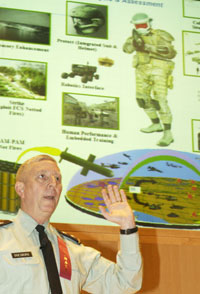For more archives, go to the Advance Archive/Search Page.
Fuel Cell Technology, Deployment
Focus Of International Conference
The most important weapon the U.S. deploys around the globe - a soldier - is bogged down in the field with an additional 30 pounds of batteries.
 |
Maj. Gen. John Doesburg, head of the U.S. Army Research, Development and Engineering Command, says the Defense
Department looks to academia and others for new energy ideas. He spoke at UConn during the first International
Conference on Fuel Cell Development and Deployment. Photo by Peter Morenus
|
Reducing that heavy burden while increasing mobility is at the heart of the military's interest in alternative energy, said Maj. Gen. John Doesburg, head of the newly established U.S. Army Research, Development, and Engineering Command.
Speaking to an audience of 300 scientists at the first International Conference on Fuel Cell Development and Deployment at UConn, Doesburg described how soldiers currently stationed in Iraq and Afghanistan not only carry their own food, weaponry, and water, but also haul up to 11 different batteries to power computers, sensors, and a variety of other equipment.
"The Department of Defense is looking to academia and industry, as well as federal laboratories, for novel energy ideas," said Doesburg.
He said that the Connecticut Global Fuel Cell Center, a division of the School of Engineering, is one of the research centers the military
is leaning on. The UConn research team has so far received $6.5 million from the U.S. Army to develop micro-miniature portable fuel cells for field applications.
The center, together with the Electrochemical Society, sponsored the three-day conference, which offered participants from academia, industry, and government an up-to-date review of worldwide developments in the technology and manufacture of all types of fuel cells.
Doesburg's unit, referred to as RDECOM, was established on March 1 as part of the Army's effort to strengthen its military research, development, and engineering. RDECOM has been given the responsibility for achieving three-quarters of the Army's science and technology objectives. One-third of its $3.5 billion operating budget is designated for research and development of new power and energy technologies.
RDECOM's slogan is "technology to the warfighter quicker." Doesburg told the audience that power and energy underlie four transformational technologies the Army has identified as necessary to the military of the future: nanotechnology, biotechnology, robotics, and advanced computing.
Doesburg pointed his own uniform - which looked conventional but was fully water-repellent - as an example of what nanotechnology has accomplished. But he stressed that further advancements hinge on a reliable, lightweight power source, such as fuel cells.
Using nanotechnology to embed sensors in a uniform would enable the soldier's movements to be tracked, while body temperature and stress level are monitored. But this technology, said Doesburg, will only be feasible when a sustainable, reliable, and mobile energy source is available.
The audience also heard how fuel cells could extend the length of military missions and relieve the logistical headaches caused by the need to recharge and replace batteries.
Doesburg, whose career with the Army has spanned 34 years, was one of four keynote speakers during the conference. Other presenters included Frank Preli, vice president of engineering for UTC Fuel Cells; and Bruce Utz and Patrick Davis, both affiliated with the U.S. Department of Energy.
The conference included 100 presentations, as well as 50 posters, exhibits, and workshops. Participants were also treated to site tours of working fuel cell power plant systems at the Mohegan Sun's Energy, Environment, and Economics Education Center in Uncasville and UTC Power, a division of United Technologies Corp. based in South Windsor.

